So you’re interested in mining cryptocurrency, but you’re not sure where to start? No problem, this guide is all you need to set up your own headless litecoin mining rig—even if you have absolutely no experience with this sort of thing.
First, let’s get the obvious question out of the way: why litecoins? After all, bitcoins are worth more, right? The simple answer is that at the time of this writing, litecoins are currently the most profitable cryptocurrency to mine when you take into account how much each coin is worth, and the time required to mine one. Rest assured that if the situation changes, and another cryptocurrency suddenly surpasses litecoin as the best mining option, the rig outlined in the guide should have no problem switching over to a new coin.
This guide will be broken into several parts, each focusing on a different aspect of building your first mining rig. First, let’s take a look at what you’ll need in terms of hardware to put a respectable miner together.
Build your own Litecoin Mining Rig, part 1: Hardware
4/06/2017: This guide is roughly three years old. Please don’t attempt to buy any of the hardware recommended here—it’s quite obsolete! If you’re looking for information about modern GPU mining, please click here for my updated 2017 guide on mining Ethereum.
Here is the list of hardware that I recommend:
| Motherboard | ASRock 970 Extreme4 |
$98 |
| Processor | AMD Sempron 145 |
$38 |
| Memory | 4GB G.SKILL DDR3 SDRAM (2 x 2GB) |
$46 |
| Power Supply | Seasonic 860w Platinum PSU |
$199 |
| GPUs | 3 x MSI Radeon HD 7950 3GB GDDR5 (Twin Frozr) |
$319 each |
| (optional) | 3 x PCI-E riser cable | $5 each |
| (for dummy plugs) | 68 ohm 1/2 watt resistors | $3 |
Update 11/26/2013: The Radeon 7950 video cards are sold out pretty much everywhere. They’re still the best option for mining if you can find them, but if you can’t, then the new Radeon R9 280X cards are likely your best option. They do consume a fair bit more power though, so you”ll want to upgrade your power supply as well (this 1250w Seasonic should support three 280X GPUs without problems). As for brands, I recommend these Sapphire, Gigabyte, and MSI 280X cards for now. I’ll be updating the rest of my guide at some point in the near future with optimal settings for the 280X, so stay tuned.
Update 12/01/2013: If you’re trying to put a rig together, you’ve probably noticed that the above video cards have become nearly impossible to find. I’ve received a few messages from folks that are having some good results using the R9 290 cards, although they’re a fair bit more expensive than the 280X. If you’re itching to build a rig ASAP and can’t find a 7950 or 280X, then you might consider the 290. It looks like all of the current 290 cards are using AMD’s reference cooling design at the moment, so brand probably doesn’t matter too much. Although given a choice, you usually can’t go wrong with Sapphire, Gigabyte, and MSI. Again, remember to pick up a fairly powerful PSU if you’re going to run 3 of these in a rig.
You will also need a USB stick (8GB or larger, this one is fine) if you’re using Linux as your OS, or a harddrive (a cheap SATA drive of any size will do) if you’re using Windows. I will cover setup on both Linux and Windows in the next sections of this guide, as well as the pros and cons of each.
The video cards may be difficult to find, as they’re popular and often sell out. You can substitute nearly any 7950-based GPU, but if you have a choice, go for the MSI or Sapphire cards. They’re not voltage-locked and will save you some electricity in the long run. I have the MSI card that I recommended in all of my rigs, but I’m told that this (and also this) Sapphire card is also a good choice.
The motherboard, CPU, and RAM are all relatively unimportant. The motherboard simply needs to have enough PCI-E slots to host your three GPUs (if the recommended board isn’t available, here is another, or if you can’t find either ASRock, this Gigabyte board is a good alternative). The CPU will essentially sit idle, as all of the actual mining is done by the GPUs. The Sempron 145 is an excellent choice here because it’s cheap and draws very little power (if the Sempron is unavailable, this one is also a fine choice). If you’re going with Linux, you can get away with even less than 4GB of RAM, but I’d stick to that as a realistic minimum on Windows.
The power supply is important, and you don’t want to skimp on it. The Seasonic that I’ve recommended is extremely solid and 93% efficient, which will help keep power consumption to a minimum. It’s also modular, which is really nice if you’re putting this together in a plastic crate like I recommend.
The PCI-E risers aren’t strictly necessary, as all 3 GPUs will fit on the motherboard without them. However, airflow will be extremely limited due to the close proximity of the cards, and I really don’t recommend setting them up that way long-term. The riser cables allow you to position the GPUs off of the motherboard in a more spaced-out fashion. I dropped the temperature of my GPUs by nearly 10 degrees Celcius by simply using risers to separate them. Availability and pricing on Amazon is constantly changing, so check eBay if you can’t find them.
Important: you may also need to create dummy plugs for each of your GPUs. Some operating systems will idle video cards that do not have an active monitor connection, which will obviously kill your mining performance. Dummy plugs “trick” your OS into thinking a monitor is connected, thus preventing attached GPUs from being idled. You just need a few resistors ($1-2 at Radio Shack if they’re not available at Amazon) and these instructions to create your own plugs.
So you’ve got nearly $1400 worth of hardware, but no place to put it, as I haven’t mentioned a case. I highly recommend against trying to cram 3 GPUs into a conventional PC case. A plastic crate or two works far better due to the tremendous heat that the video cards will give off. Added bonus: they’re cheap!
Here is what you’ll need to create a simple DIY plastic crate housing for your miner:
| Plastic Crate |
$5 each |
| Plastic stand-offs | $4 |
| 6 x #4 3/8″ wood or metal screws | $1 |
| Brace to rest GPUs on (I used two of these) | $4 |
| a few cable ties (8″ or so) | $2 |
| power switch & LED (optional) | $6 |
You can get plastic crates in most home improvement stores if you don’t want to ship it from Amazon. I picked mine up at Lowe’s for under $5 each. You should be able to get everything else on the list at Lowe’s if you happen to have one near you, too. As far as tools go, you’ll need a drill and a knife capable of cutting into whatever plastic crate you buy.
Assembly Steps:
First, attach your CPU & heatsink/fan to your motherboard, and place your RAM into the memory slot(s). Then follow the general steps below to mount everything into your plastic crate.
Click the images for a close-up look at each step.
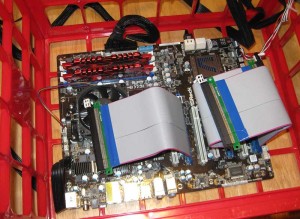 Place plastic standoffs on the bottom of your plastic crate, and rest your motherboard on top of them. Make sure that all of the essential ports are accessible (SATA, USB, keyboard, mouse, etc). Use your knife to cut away pieces of the crate if necessary so that all ports you plan to use are exposed. Then plug your riser cables into the PCI-E slots of your motherboard.
Place plastic standoffs on the bottom of your plastic crate, and rest your motherboard on top of them. Make sure that all of the essential ports are accessible (SATA, USB, keyboard, mouse, etc). Use your knife to cut away pieces of the crate if necessary so that all ports you plan to use are exposed. Then plug your riser cables into the PCI-E slots of your motherboard.
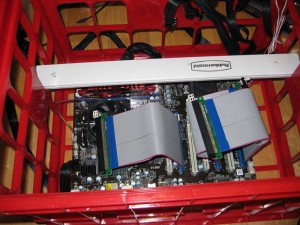 Place your brace (either the plastic guards that I recommended, or a cut yardstick, or whatever you have that works) so that it is sitting above the motherboard, high enough for your GPUs to rest on. Cut the brace so that an inch or two sticks out on either end of the crate.
Place your brace (either the plastic guards that I recommended, or a cut yardstick, or whatever you have that works) so that it is sitting above the motherboard, high enough for your GPUs to rest on. Cut the brace so that an inch or two sticks out on either end of the crate.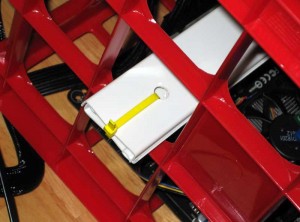 Drill holes in your brace so that you can secure it with cable ties (see image). Do not simply rest the brace on the crate! An accidental bump can cause it to fall into the crate, along with ~$1000 worth of GPUs if you do that!
Drill holes in your brace so that you can secure it with cable ties (see image). Do not simply rest the brace on the crate! An accidental bump can cause it to fall into the crate, along with ~$1000 worth of GPUs if you do that!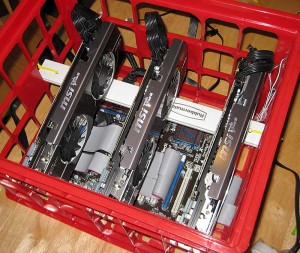 Connect each GPU to it’s corresponding riser cable, resting the bracket end on the lip of the crate and the other end on your brace.
Connect each GPU to it’s corresponding riser cable, resting the bracket end on the lip of the crate and the other end on your brace.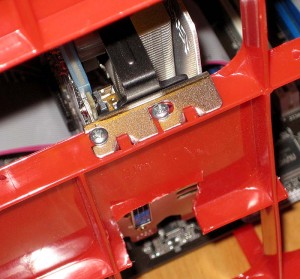 Screw each GPU down into the lip of the crate. If you drill small pilot holes ahead of time (mark where to drill with a sharpie), this is much easier.
Screw each GPU down into the lip of the crate. If you drill small pilot holes ahead of time (mark where to drill with a sharpie), this is much easier.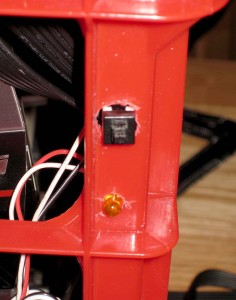 If you have a power switch and LED, mount them into one of the crate’s corners. I was pretty sloppy with mine, but it’s functional.
If you have a power switch and LED, mount them into one of the crate’s corners. I was pretty sloppy with mine, but it’s functional.
You’re done! Simply connect everything to your power supply and you should be ready to power your rig on for the first time. If you have a second crate, you can put your power supply in there (along with your harddrive if you’re using Windows), and stack it under your main crate to save some space.
In the next part of this guide, I’ll show you everything you need to do to start mining under Linux (and Windows will follow shortly after)!



 April 18th, 2013
April 18th, 2013  CryptoBadger
CryptoBadger 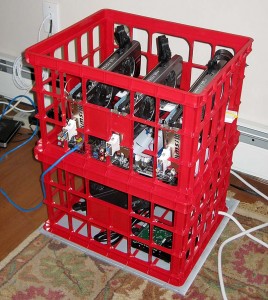
 Posted in
Posted in  Tags:
Tags: 


[…] going to need to make a case to hold all these components and for that I would suggest the simple milk crate case build that I followed from Cryptobadger.com. He has an excellent write up to get you started mining; including everything from hardware to […]
Would this setup work with 3 x r9 270 twin frozr Will donate if useful info thanx
sure you can use this build with 270s. Why not?
I just wouldn’t do the milk-crate thing, even if it is pretty open, the warm air might be a problem if you want to push the cards.
Good luck and have fun (that’s what this type of builds mainly are)
I used the milk crate build with 280x cards, so why not 270’s? My build worked out fantastic. I never have temps over 72.
Hi Altcoinmoneybags,
I’m just a newbie but what I understand about power supply is that all kinds of bad things can happen if you are underpowered. What I was told was that even if a power supply has a safety to prevent too much draw; if the PS is underpowered at some point the rig will take out the safety and you will basically be drawing power straight from the wall or some variant of that. So everything gets screwed up in various unpredictable ways.
The trouble is that with the 860 and the cards we have there aren’t enough PCI-e connectors;we are one short because the mb needs one. And they give you (which really doesn’t help) a couple of 8 pin lines that split into two 6+2s. So then you end up hooking up only one connector from the power supply to two connectors on the card. I think each PCIe
connector is limited by spec to a max of 75 watts at the PS so there you are supplying the card with only half the wattage it needs. Or you are pulling twice the current down one line that it can hold.(I don’t know which but I’m guessing either is probably bad.)
So I’m just buying another power supply (1250W) with more connectors and more cabling so that I can hook two of the PCIes at the PS to two of the 6 pins on the cards either with a twelve pin like Edward that splits into 2 6+2s or two cables with 8 pins on the PS end.
I think that everyone else has different cards that use a bit less power but Edward describes his rig with 7950s drew 900 watts from the wall which is actually over what our supply is rated for. I’m guessing its better to have a much bigger PS that isn’t working hard for more system stability in the beginning.
I’ve just started though, am completely inexperienced, and haven’t even fired the rig up yet( I’m waiting on the new PS). I’ll let you know how it goes.
For starters, you can set up your rig with one card less just to get it going 😀
I am using on my 2nd rig two PSUs – 2x750W Pt was about the same as 1250 and cheaper than 1500. And you get more than enough connectors.
One thing to understand regarding usage – even if you read 900W your 750 delivers 750 (or less) to the system. It’s the efficiency that counts, so usually Bronze have less efficiency and can only deliver 80% (?not sure on the numbers). Plat is 95ish I think. So if you have a 1000W Platinum at full 1000W draw from wall you deliver 950W to the system. You can’t deliver more than what it is specified, i.e. 1050W is not possible (in theory). But, it might draw 1050W from wall if you deliver more than 950W to the system.
Hope my rambling helps.
There’s been a few questions recently about PSUs. I’d really value an expert view on this. I have 3 x 7950 on a 860W Seasonic using powered risers. There are plenty of leads supplied with the PSU to rig all these up (with space on the PSU to spare).
In my set-up I have:
– the three powered risers running off a single PSU lead that has three molex outputs.
– One GPU runs off a single lead that splits into two plugs which go into the GPU.
– Another runs of two separate leads (one to each GPU connector).
– The last card is connected to Molex plugs.
The rig is running fine (c. 590 kh/s) but is there any issue powering the rig in this way? Some people seem to be implying otherwise and clarification would be useful.
Yeah 850 will be more than enough 7950 only consume around 138watts and you are well under the rated power of that psu.
Hi Shiftking,
How do you tell what your GPU wattage consumption is. I could get nothing from Sapphire on this. I’m guessing experience.
GO TO EBAY
KIL-O-WATT
TELLS WATTS
AMPS
VOLTS
HANDY GADGET
Hi Mole,
The plug that splits into two might be a problem. Sapphire and Seasonic are very unclear on this except that they say you have to have two lines.
Unless you used two of them? But then you need one of the PCI-e connectors for the motherboard so I’m guessing not.
Thanks Alex yes that helps. I wasn’t at all clear about efficiencies.
I worry about starting with less cards because people have had a problem getting cards recognized by the system when they added one later. I think there’s a fix but I’d rather get one rig started fairly simply and do more experimenting later.
** Litecoin Mining Parts Online Store **
http://www.litecoinminingparts.com
Powered riser cables
2.8MH/s ASIC Rig
2.8MH/s GPU Rig
Dual PSU cables
Aluminium Frames
Molex adaptors
Worldwide shipping.
Hello,
i got 2 R9 290.
They only have dvi-d ports.
That means i cant use the usually dummy plug.
The only way for me is to attache my display to the miner.
Have someone a idea how to build a dummy plug for dvi-d?
Its possible to use a dvi-d cable as dummy?
Use a DVI-to-VGA adapter.
THEY WILL MINE FINE WITHOUT PLUGS….LEAST MINE DO
Hello SHAGTIME MINER,
thx for your reply.
my system only mines at ~50% without plugs.
it seems to be a mainboard thing.
Hello James,
thx for your reply
dvi-vga adapters dont fit in a dvi-d port.
They do if you have the right adapter. 😉
http://www.amazon.com/Male-DVI-D-Female-VGA-Adapter/dp/B007EA48MA/ref=sr_1_1?ie=UTF8&qid=1392750108&sr=8-1&keywords=dvd-d+to+vga
I built the same rig as you except used 3 by Sapphire 7950s and used a 1200i platinum power supply from Corsair. I use the riser cables to separate my GPUs in the crate. If I set the intensity to over 14 within a few minutes the whole system shuts down. If I go over 16 the whole thing shuts down immediately. Any ideas why?
What is your model number? And what are your other settings? I have Sapphire 7950s at I 20 no problems.
Is it possible to run a mix of XFX R9-280x and XFX 7950s in the same rig?
In principle, yes. It would make tweaking of your hash settings a bit more difficult, since you won’t be able to use the same for both types.
Of course you can, probably easier, run 2 instances of a miner, and using enable/disable settings of certain GPUs.
Don’t forgot to have enough juice for your rig….
I’m building a new system and on this motherboard the PCI express slots are very well placed; so this will be the first time I won’t need risers.
Anyways, I was wondering if I don’t use risers, do I need anything else to brace the graphics card or is it ok to just let it, “freely hang”.
May I ask the mother board you are using please.
ASRock Fatal1ty Z87 Killer.
I still may need to use 1 riser depending on the temperatures. But at least 2 of the cards will not use risers.
Hi Vitalia, I’ve done the just let it hang approach and its very reliable although you should consider the weight of the GPU’s. With 2 GPU’s its fine, if you’re going more than that it might get a little heavy. If the mobo is built for 4 GPU’s, you should be ok.
Been a while since I posted here, but I was wondering if anyone has experienced hanging in CGMiner 3.7.2 on startup where you can’t even exit (Ctrl-C doesn’t work, even kill -9 doesn’t kill it)? I have a rig that’s been running for weeks fine and after a reboot today, I can’t restart cgminer, it just hangs on “Started cgminer 3.7.2”.
I tried aticonfig –lsa to make sure all GPU’s are detected (they are).
I tried cgminer -n although any command to cgminer seems to hang (it hanged here).
I tried re-installing cgminer 3.7.2, same.
I’m at a loss here, no idea what’s wrong with cgminer?
cgminer 3.7.2 forked to sgminer 4.0.0. I’ve noticed that when I updated to sgminer that the I get more stable hashrates with less of the hassle. I highly recommend it.
Whenever cgminer freezes and you can’t shut it down, it’s always been a setting issue (at least for me).
-Too high intensity.
-Too high overclock.
-Not enough power allocated to the card.
Sometimes graphic cards need to be meticulously overclocked.
The two times I’ve encountered this are:
XFX 7950 core clock was too high at 1050. I had to reduce to 1025.
MSI 7950 with Gigabyte F43 Bios core clock was too high at 1000. Reduced it to 980 and now I don’t have to restart my computer because cgminer locks up.
Hmmm, cgminer -n hanging is very odd to me as it really indicates something seriously wrong as that just dumps a list of cards, no actual mining happens with that setting.
I was able to find sgminer 4.0 (there’s also a 4.1 now) but I’m seeing compilation instructions as all out of date. Is there a downloadable binary that I can download like cgminer 3.7.2 had?
Thanks Vitalia!
PS: Non-windows distributable 🙂
Hi, I got sgminer 4.0.0 working but I’m having very low hash rates 550 Kh/s versus 765 Kh/s that I had before. Hmmm, at least its working again, but at 30% lower rates than expected. Any suggestions on tweaking? Using the same settings I had on cgminer from before for overclock.
Are you sure you have network connectivity?
Did you try uninstalling and re-installing?
Yup, I’m connecting to the server via SSH and there’s another rig on the same network. I tried re-installing CGMiner 3.7.2, same issue.
Hello,
If you had to redo a rig like this today, what list of hardware would you recommend (motherboard and GPU most importantly) considering the price increases and possible hardware updates?
Thank you for your answer.
In fact, I haven’t missed anything. I have actually read thoroughly all the guide. The last update to the hardware section is now close to 3 months old, thus my question. Thank you anyways. Cheers.
I have a question.
I purchased the seasonic 860w plat PSU and three 7950’s at the recommendation of this article, however, the psu, although the box says it has 6pcie connectors, it actually has 2 cables with two plugs for pcie, and another cable with a single pcie plug.
How did you hook up all 3 vid cards to power??
Check what other cables you have, there’s typically SATA and MOLEX cables as well that you can buy converters for. If you just need 1 6-pin, a single molex->pcie can do it. If you need an 8-pin, you’ll probably need 2 molex->pcie. Try not to use molex converters as you may need those for powered risers.
If some one wishes expert view about blogging and site-building after
that i advise him/her to pay a visit this
website, Keep up the pleasant job.
Here is my blog post … newsela (Chanel)
Hello,
I am having problems and I think is the PSU, I just want to confirm before I buy a new one. My PSU is Nox Urano TX 850W, and I can minet without problems with two GPU. I have tried different versions of cgminer and xubuntu and always I have the same problem. If I try to mine with the 3 GPU, system freezes after a few minutes.
I believe is a PSU problem, but I don’t know if the PSU is defective or simply this PSU is not very good because is cheaper (55€).
Any help/recomendatios are welcome.
Thanks!
Hi Jessie,
You might be cutting it a bit close on power. I just started my rig with
3 hd7950s and it’s pulling 812 from the wall(using a kill-a-watt to measure). I haven’t done any optimimizing yet though. The PSU is 90 percent efficient though so it’s actuallysupplying about 730 watts to the cards,mobo and hard drive. Also at least one of the cards should have a powered riser cable so that the cards don’t draw too much power through the motherboards 12V atx connector. If you can’t get that you can just buy the EVGA powerboost and install as per directions. It powers the PCIe bus ( my understanding is that all the connections are just part of one bus so powering any one of the open ones does the trick).
Not really cheap I must say.
Maybe he was referring to the quality of the products, instead of the price. Heh
Perhaps, although cable risers (and such) quality is pretty much the same everywhere, and to be honest it’s bad. As for an aluminium rig frame of 195 USD…. PLEASE!
Hi All,
Well I finally got my rig up and running (still with bated breath
the video card drivers situation was a bit rough- the older ones shut down cgminer immediately and the newer ones that came with the cards shut them down down a few hours after I left the unit by itself. I’m running windows 7 pro. I figured perhaps the newer catalyst drivers were looking for something pushing pixels so I just ran a short movie in windows media player over and over again. Later I just paused it and then took off the screen and attached the adapter with the resistors. So far so good; it’s still hashing away and keeping my cat warm.
But I wanted to use the tightvnc to monitor it. How do I tell where my computers are? This is a really newbie question I realize. The internet IPs change I think. Do I have to set up a network ( I know nothing about this right now).
oh btw I am running 3 hd7950 dual x’s on an ASRock 970 extreme4. Also I am now running cgminer 3.73 Kalroth version which may be helping also.
So with the initial investment plus the charge for electricity – what are you guys seeing for monthly ROI?
So it is highly speculative but if your careful with power consumption then your rig should pay for itself in 6-8 weeks assuming. Of course you can’t overspend on parts etc and there is every possibility the bottom can fall out but not likely. All rational conversation. Aside it is nerdy and fun as hell, just saying.
6-8 weeks?? I calculated 4 to 6 months! I’d love to see your breakdown. At current rates, here is mine:
My initial investment was about $1900, give or take $100. Rates are currently between 2200 KH/s and 2310 KH/s
My daily profit is averaging about $13/$14 a day, that’s after power costs.
$1900/$13 = ~146 days = ~4.8 months
TRY MINING A DIFFERENT COIN LIKE SOLAR(SLR) 2200KH WILL GET YOU 2748 COIN PER DAY @ 2 CENTS A COIN …..YEP THATS A 50.00 DOLLAR BILL A DAY!!!!!!!!!!!!!!
Shagtime, Sounds almost too good to be true. Is there a wallet for Solar? Which exchange can be used to convert Solar to BTC or LTC or $USD? My present rigs would produce approx. $100/day if what you say is true and there is actually a way to convert Solar(SLR) to a useable coin or to USD.
Really stupid question here. Building my first rig using a milk crate. I don’t have the on/off button that would normally come with the case. Is there a work around? or do I have to track down a switch, which i would probably have to order.
Jay;
COPYING THIS FROM THE INSTRUCTIONS:
“Here is what you’ll need to create a simple DIY plastic crate housing for your miner:
Plastic Crate (get 2 if you want a place for your PSU) $5 each
Plastic stand-offs $4
6 x #4 3/8″ wood or metal screws $1
Brace to rest GPUs on (I used two of these) $4
a few cable ties (8″ or so) $2
{power switch & LED (optional) $6} THIS WILL BE YOUR ON/OFF SWITCH;
OR, If you are using ASRock 970EX4 it has a on/off button on the mobo. Also most newer mobo have a switch on the board itself.
Does anyone know the difference between a 280x and 280? The prices of 280x are through the roof but 280’s are still more reasonable. They have the same number of shaders and they seem to be marginally the same? Anyone have experience with a 280?
Hi everybody,
Can i use 4 GPU for this mainboard, 1 GPU will run at 1x PCI express.
Do you have any suggesstion ?
Yes, you can run 4 GPUs on this motherboard.
What would I have to do if I wanted to have 6 graphics cards, or even 9 instead of just the three that this guide talks about?
I’d appreciate any information!
Conor,
It would depend upon which mobo you are using but you could easily run 4 cards per mobo and possibly five if the mobo has 5 open PCIe slots. You can use 16 x 16 and also 1 x 16 slots with risers. You will have to consider the wattage for each rig and make sure you have a PSU with enough Wattage rating to handle 4 or 5 cards per mobo. You will need at least 1250W or 1350W PSU for up to 5 cards. You can save some electric usage by undervolting the cards once you have your rigs running. Four Sapphire HD 7950 cards will pull approximately 900 to 1000 Watts at the wall. I have two rigs running 4 HD 7950 each and they are pulling about 2000 watts at the wall.
Do you think you could recommend a motherboard that would fit this description? I would be fine with 8 280x, being paired together between two motherboards. Also, I would then need two separate power supplies, one for each mobo? Correct?
Thanks!
The AsRock 970 extreme 4 in the guide has 3 16x and 2 1x PCIe slots. I run 5 cards from mine (with Linux).
There is a Gigabyte mobo with 6 slots and an ASRock BTC-80 with 6 1x slots.
But have you made diff vs price vs electricity comparisons yet? To date I have been running two rigs with ten cards and I am now selling 4 on eBay. GPUs’ days with litecoin are numbered. I mined 126 LTC since December, spent AUD$6000 on gear, spent AUD$2000 on power, with an approx av sale value of AUD$3000 for the coins. It’s very speculative and I would have a better potential ROI by buying LTC.
Pre-order an ASIC product and be done with it, or if you think the litecoin price will go to the moon, then buy some.
Ahh yeah, that makes sense, I’ve heard that ASIC is the way to go. Sorry for asking so much of you, and I appreciate all this help, but could you point me in the direction of a website that sells ASIC and is reliable? I’ve heard a lot of sites are sketchy and what not. Maybe even go a step further and recommend a solid ASIC product itself?
None on the market yet. I have pre-ordered mine from Fibonacci.io.
So is it safe to assume that GPU miners will be useless once these come on the market?
“Jasinlee”, the CEO of Fibonacci, is committed to the litecoin project and he’s delaying release of hardware after hosted mining until competition have released theirs without reverse engineering, to keep the technology more distributed. These ASICs are not the orders of magnitude faster than GPUs that bitcoin ASICs are, but are much more power efficient. Even before release, GPUs are becoming difficult, due to the commencement of GPU farming that has started, as more Chinese exchanges adopt litecoin.
Conor,
You can read about a new offer for ASIC in posting by CryptoBadger on March 20 at the HOME page. Go to top of page and click on HOME.
Also I agree with Staffnsnake about the cost, etc. My two rigs are using
ASRock 970 EX4 with 4 Sapphire HD 7950 cards each. My electric bill has doubled so I figure I am spending about $120 to $130 USD each month more on electric than before I started mining.
I WISH MY BILL WAS THAT CHEAP….I HAVE 9 RIGS RUNNING
BIGGEST BILL $592.00 (LAST MONTH) PUTTING OUT 15.23MH’S
COLLECTED LITTLE PAST 2000.00 IN COIN….
……DONT KNOW HOW LONG THIS CAN GO ON WITH DIFFICULTY GETTING HIGHER
DID BITE THE BULLET AND ORDERED KNCMINER 100 MH’S 1000WATTS OR LESS
$9995.00 OUCH
And this:
https://docs.google.com/spreadsheet/lv?key=0Ap8Q0nxk-daxdDlaeFZ0TW5kbHNWWXZqWm9xYWJySFE
I recently purchased 3 Saphire HD7950’s (model 11196-19-20G). The power recommendation on the box says 500W (or greater). So, do I really need 500W of power per card or is Sapphire overstating the case? Most things I see on the web say that 200-300W per 7950 is more realistic. I want to make sure I have plenty of power, but no need to buy more power than I actually need. Thanks for looking!
Mike,
I am running 2 rigs with 4 Sapphire HD 7950 cards each. The 4 cards will pull around 1000 watts at the wall. I would recommend using a 1250W or 1350W in case you want to add cards in the future. When I was running only 3 cards on each rig, they would pull about 950W until I “undervolted” the cards. Some of my cards would work fine at 1.094v but several of the cards I had to leave at 1.125 or 1.131 for them to be stable.
Edwardf: Thanks very much for your succinct info. It was exactly the type of first-hand experience I was hoping to hear. Thanks again!
Hey there if i have a new setup with 2 r9 280x does cgminer detct both or do i need a dummy plug for 1 of them?
If you’re running xubuntu 13.10 and cgminer-3.7.2 then you do not need dummy plugs.
Has anyone built a machine with a Radeon HD 7990 6GB DDR5 graphics card. If so, what hashrate are you getting? I have two of these and was thinking of mining with them. Thanks.
925 KH’S
Thanks.
I just ordered some parts to put my Machinery together.
Fallen on difficult time folks. I’ve got about $5k of gear in the basement that I need to liquidate quickly. 9x MSI R9 270, 2x ASRock 970 Extreme4, 2x ASRock H81 Pro BTC, 4x EVGA SuperNOVA 1000 G2, CPUs for each board, and more. I’ll be setting up an e-commerce store so you can buy (sure as hell not going to do it on eBay’s new cryptocurrency marketplace.) I’m looking for $150 for the GPUs, $100 for each MoBo, $200 for the PSUs, etc. I’m not trying to make money here. Ask an honest question, you’ll get an honest answer. Feel free to email me at wedge07@gmail.com. Thanks everyone.